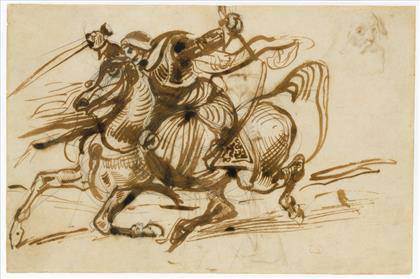
Eugène Delacroix (French, 1798–1863). The Giaour on Horseback, 1824–26. Pen and iron gall ink with wash over graphite. 7 15/16 x 12 in. (20.1 x 30.5 cm). The Metropolitan Museum of Art, New York, Gift from the Karen B. Cohen Collection of Eugène Delacroix, in honor of Jane Roberts, 2015 (2015.713.2)
Drawings by Delacroix at the MetMuseum ‘Devotion to Drawing: The Karen B. Cohen Collection of Eugène Delacroix’ explores the central role of drawing in the artist’s practice through more than one hundred works. Metropolitan Museum of Art, July 17 – November 12, 2018.]]>
Source: Metropolitan Museum of Art
”Devotion to Drawing: The Karen B. Cohen Collection of Eugène Delacroix” begins with an examination of drawing as a method of training and study for Delacroix throughout his career. This section presents academic and anatomical drawings; studies from life and nature; and copies after a broad range of sources, from old master prints after Raphael and Rubens to contemporary caricatures by artists such as George Cruikshank. Among the highlights are two of the artist’s sketchbooks: one from an 1829 trip to Normandy and the other of costumes sketched during an 1855 performance of Othello in Paris.
The second section of the exhibition looks at how Delacroix used drawing to invent, research, and refine his ideas for paintings on canvas, decorative and religious murals, prints, and illustrations. It features drawings for a number of his major paintings, including “The Massacre at Chios” (1824), “Liberty Leading the People” (1830), and “The Sultan of Morocco and His Entourage” (1845). A group of drawings related to his first important commission for the French State—the decorations for the Palais Bourbon—reveal the dynamism of Delacroix’s premières pensées (first thoughts) executed in fluid pen and ink. More precise preparatory works in graphite demonstrate the care with which Delacroix planned his prints, from his early satirical subjects to his landmark illustrations for Hamlet, published in 1843. The drawings are paired with their resulting prints, enabling first-hand comparisons of the studies with the finished lithographs.
The third and final section of the exhibition reveal how Delacroix reveled in the aesthetic possibilities offered by graphic media including ink, wash, and watercolor. The works in this section also emphasizes how drawing was a means of invention for Delacroix. The intense study and preparation demonstrated in the earlier sections of the exhibition comes to fruition here in drawings that show the artist’s imagination at work on paper.
Related content
Eugène Delacroix: Liberty Leading the People (series “50 masterworks of paintings”)
Follow us on:


